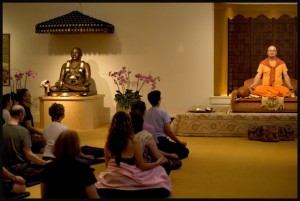In the Vedas, a person who performs Vedic ritual sacrifice was called a Brahmin. Brahmin means “twice born.” The Brahmin is twice born because he receives an initiation that qualifies him to perform the sacrifice. It’s the beginning of his education and the beginning of a commitment that he makes to peel away the layers of the tensions that bind us together as a person. Those are tensions that we have accumulated through so many lifetimes, and that have manifested in this lifetime as the disappointments of our ancestors we’ve inherited. The desires that we manifest, the aspirations that we have, the areas that we go into in our lives, both constructive and destructive, are really an expression of the deficiencies in the nourishment of our upbringing. Those deficiencies are not there through anybody’s fault; they’re just what is.
In the Vedic times, for Brahmins, this initiation lifted them out of the family circumstances they were born into and immediately liberated them from the disappointments of their ancestors. They were born again into a different circumstance called a guru kul. The guru kul is the family of the guru, the family of the teacher. The tradition recognizes that the guru kul makes available the nourishment that wasn’t provided in the birth parents’ home. That nourishment dissolves the tensions that limit a person in every dimension of their life. It makes it possible for them to become completely spiritually developed and mature, totally fulfilled, and liberated in life.
The central part of the initiation experience is when the guru takes his own conscious energy, his own awareness power, and plants it in the student, so that the energetic mechanism of the student acquires the nourishment needed to start to break down all of the accumulated tensions. As those tensions are broken down, the vital force within the person is awakened and expanded.
This was the critical moment in Vedic initiation, and the practice continued through all the various traditions in India. The Vedas were followed by the Upanishads, and then the six classical philosophical systems, including yoga, which ultimately matured in the Tantric tradition.
The Tantric tradition was unusual in its complete maturity because it asserts that there was only one consciousness in the universe. Even though there are many minds, there is only one consciousness. It is that one consciousness that the teacher is established in and through which their life force is transmitted to the student. That is called “shaktipat” in the Tantric tradition. The term means “descent of grace.” In the Tibetan side of the Tantric tradition, in Dzogchen, it’s called direct transmission.
This experience that I share when I teach open eye class is not different from the Vedic initiation. It is the transmission of the understanding that there is a singular dynamic awareness from which all phenomena arise, and that all phenomena are interconnected. So this interconnectedness, the understanding, the experience, the awareness of this interconnectedness, is what is being transmitted as shaktipat, or initiation. It is the continuing awareness of that connectedness that represents a leverage on all the tensions that we’re walking around with.
So, no matter what our condition is, no matter what our experience is, no matter what kind of confusion we’re experiencing, we have a reference point we can always go to. This experience is also an energetic resource we can draw on to lift ourselves out of whatever limited state that we have fallen into.

